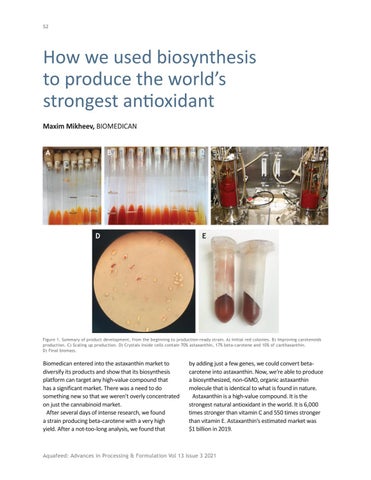52
How we used biosynthesis to produce the world’s strongest antioxidant Maxim Mikheev, BIOMEDICAN A
B
D
E
Figure 1. Summary of product development, from the beginning to production-ready strain. A) Initial red colonies. B) Improving carotenoids production. C) Scaling up production. D) Crystals inside cells contain 70% astaxanthin, 17% beta-carotene and 10% of canthaxanthin. D) Final biomass.
Biomedican entered into the astaxanthin market to diversify its products and show that its biosynthesis platform can target any high-value compound that has a significant market. There was a need to do something new so that we weren't overly concentrated on just the cannabinoid market. After several days of intense research, we found a strain producing beta-carotene with a very high yield. After a not-too-long analysis, we found that
by adding just a few genes, we could convert betacarotene into astaxanthin. Now, we’re able to produce a biosynthesized, non-GMO, organic astaxanthin molecule that is identical to what is found in nature. Astaxanthin is a high-value compound. It is the strongest natural antioxidant in the world. It is 6,000 times stronger than vitamin C and 550 times stronger than vitamin E. Astaxanthin’s estimated market was $1 billion in 2019.
Aquafeed: Advances in Processing & Formulation Vol 13 Issue 3 2021













